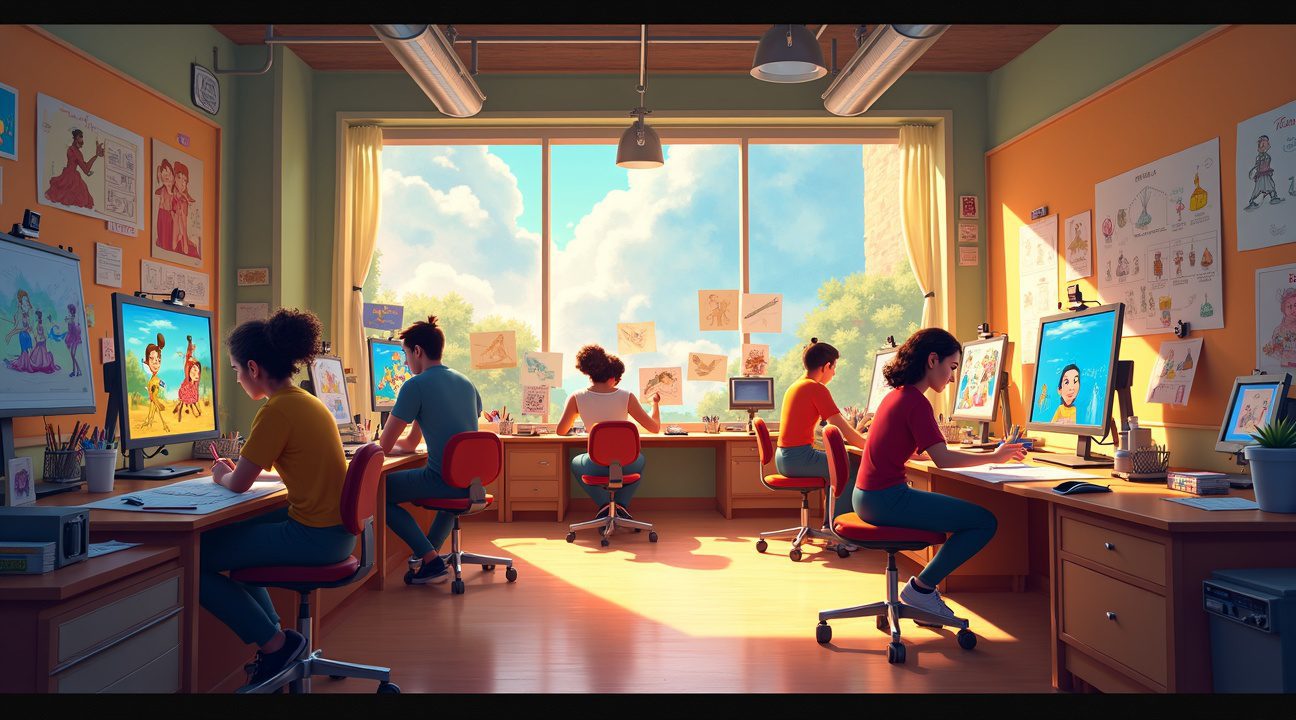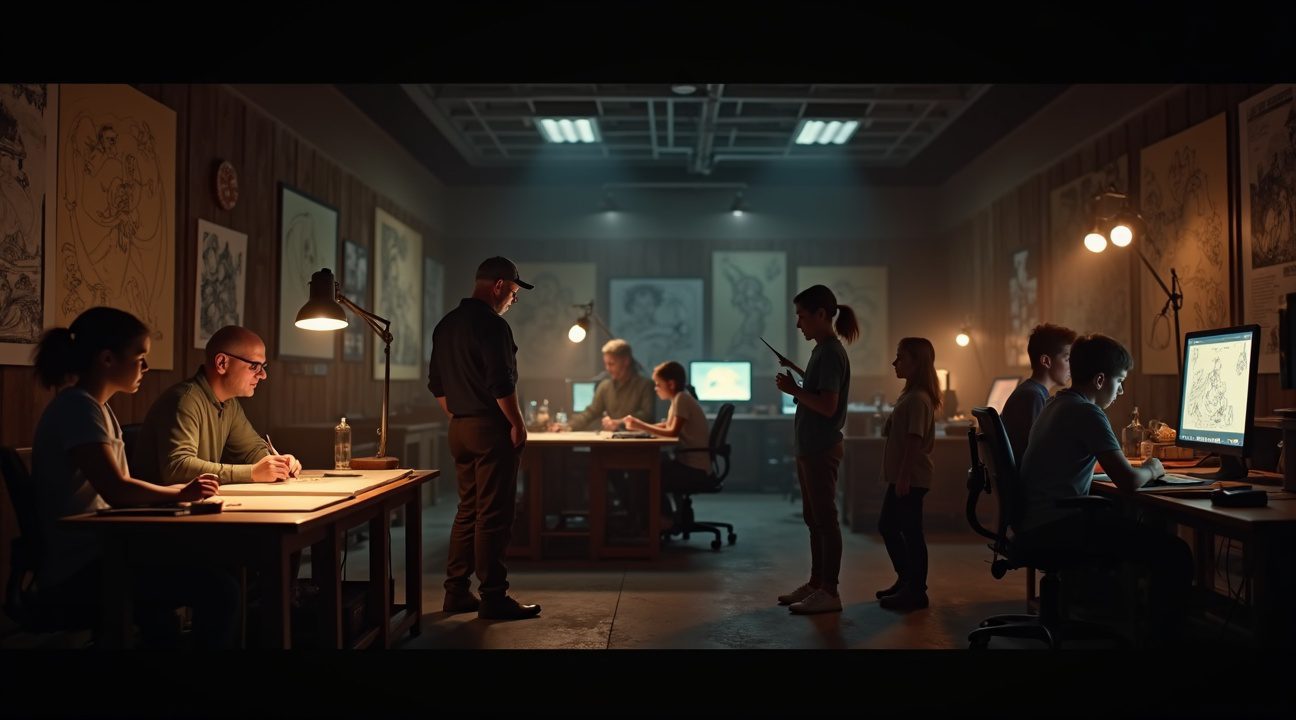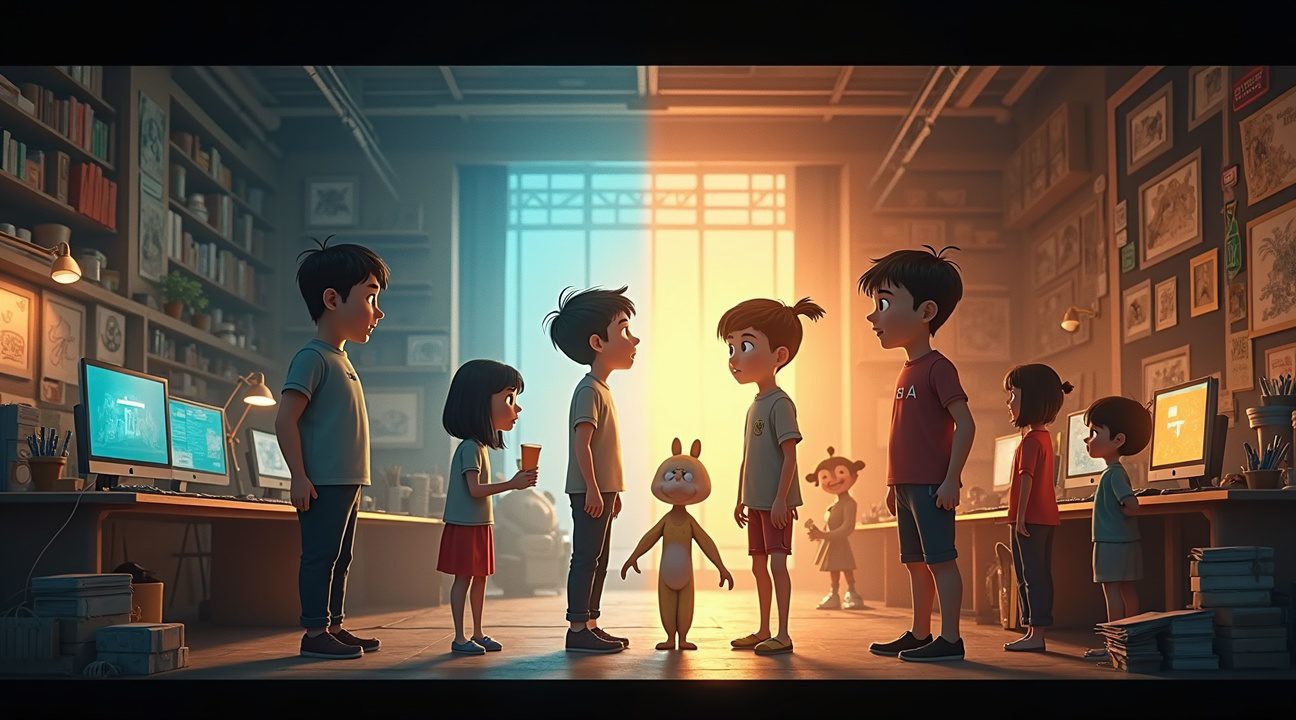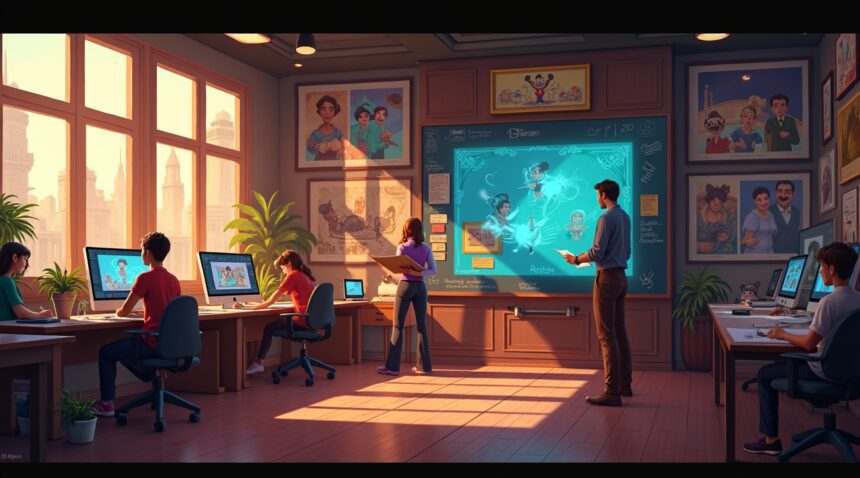Walt Disney Animation Studios is reviving interest in traditional 2D hand-drawn animation, a medium it hasn’t focused on extensively since the early 2000s, according to Chief Creative Officer Jared Bush.
Disney’s Commitment to Hand-Drawn Animation
The recent confirmation by Jared Bush marks a significant development in the animation industry. While Disney has largely emphasized computer-generated imagery (CGI) since the release of “Winnie the Pooh” in 2011, the studio is now exploring new 2D projects. However, this pivot is not driven by nostalgia, but by the need for authentic and meaningful storytelling.
Narrative Purpose Over Nostalgia
Bush stressed that hand-drawn animation would only return if it serves a “deep narrative reason.” This underscores the studio’s prioritization of story quality over stylistic choices. The move suggests Disney’s strong commitment to preserving artistic integrity within its evolving creative framework.
Key Takeaways
- Disney is actively developing hand-drawn 2D animation projects for the first time in over a decade, reinvigorating its legacy of traditional animation.
- Traditional animation will only be used when it supports the story, not simply to evoke nostalgia or as a marketing gimmick.
- The studio faces production challenges, including a limited pool of experienced hand-drawn animators and the higher production costs compared to CGI.
- Audience interest remains strong for hand-drawn films, as seen in the recent success of movies such as “The Boy and the Heron” and “Robot Dreams.”
- Disney has brought back veteran animator Ron Clements to help train new artists and rebuild its traditional animation capabilities.
Looking Ahead
This renewed focus on 2D animation could mark a turning point for Disney’s creative direction and open doors for fresh storytelling formats. To follow updates on this story and Disney’s ongoing projects, visit the official Disney Animation Studios website.
Disney Chief Creative Officer Confirms Active 2D Animation Projects in Development
Walt Disney Animation Studios Chief Creative Officer Jared Bush has sparked excitement among animation enthusiasts by confirming that the studio is actively developing 2D hand-drawn animation projects. This announcement marks a significant shift in Disney’s production strategy, which has primarily focused on computer-generated animation since the early 2000s.
Bush’s statements reveal that Disney’s current 2D artists are “doing some bonkers amazing things” behind the scenes. The confirmation suggests that traditional animation techniques haven’t been abandoned at Disney, but rather have been quietly evolving within the studio’s creative laboratories. I find this development particularly encouraging for those who’ve hoped to see Disney return to its roots while maintaining modern storytelling standards.
Story-Driven Approach to Animation Style Selection
The Chief Creative Officer emphasized that any return to hand-drawn animation would require a “deep narrative reason” rather than serving as a purely stylistic choice. This philosophy demonstrates Disney’s commitment to letting story dictate artistic direction, ensuring that animation techniques enhance rather than overshadow the narrative experience. Bush’s approach suggests that future 2D projects won’t simply capitalize on nostalgia but will use traditional animation methods when they best serve the story being told.
Several factors indicate why this story-first methodology makes sense for Disney’s creative strategy:
- Hand-drawn animation excels at conveying emotional intimacy and personal storytelling moments
- Traditional techniques can create unique visual languages that distinguish specific films from the studio’s CGI catalog
- 2D animation allows for artistic experimentation that might feel forced in computer-generated environments
- The medium provides opportunities to showcase the craftsmanship that originally built Disney’s reputation
Bush also hinted at exciting visual experimentation in upcoming productions, specifically mentioning that “Zootopia 2” will include elements that push stylistic boundaries using the new Presto animation system. This suggests that Disney isn’t simply choosing between 2D and 3D animation but is exploring hybrid approaches that combine the strengths of both mediums.
The studio’s willingness to invest in 2D projects represents a strategic response to changing audience preferences and industry trends. Recent successes in hand-drawn animation from other studios have demonstrated that audiences remain receptive to traditional techniques when they’re executed with skill and purpose. Disney’s vast resources and technical expertise position the company to create 2D films that could set new standards for the medium.
I believe this development reflects Disney’s recognition that animation diversity strengthens their creative portfolio. While Pixar continues pushing CGI boundaries, Disney Animation Studios can differentiate itself by mastering multiple animation approaches. This strategy allows the studio to match animation style with story requirements rather than forcing all narratives into a single visual framework.
The confirmation of active 2D projects also suggests that Disney has been quietly maintaining its hand-drawn animation capabilities even during the CGI-dominated era. This preservation of institutional knowledge ensures that any return to traditional animation will benefit from decades of accumulated expertise rather than starting from scratch.
Bush’s comments indicate that Disney’s approach to 2D animation will be selective and purposeful rather than representing a wholesale shift away from computer animation. This measured strategy allows the studio to explore traditional techniques while maintaining the technological advantages that have made films like The Little Mermaid successful with modern audiences.
The development of active 2D projects positions Disney to respond to creative opportunities that specifically benefit from hand-drawn animation’s unique characteristics. Whether these projects will result in theatrical releases or explore other distribution channels remains to be seen, but the commitment to developing such content demonstrates Disney’s renewed interest in animation diversity.

Growing Industry Demand Fuels Disney’s Interest in Traditional Animation Revival
The animation landscape has experienced a significant shift as audiences grow weary of computer-generated imagery dominating every screen. Studio Ghibli’s recent triumph with “The Boy and the Heron” and Pablo Berger’s critically acclaimed “Robot Dreams” have demonstrated that hand-drawn animation still holds tremendous power to captivate modern viewers. These successes haven’t gone unnoticed at Disney, where executives are reconsidering the artistic potential of returning to the company’s traditional roots.
Market saturation with CGI has created an unexpected opportunity for studios willing to embrace different visual approaches. Animation enthusiasts and critics alike have voiced concerns about the homogenization of animated features, where every film seems to follow similar visual formulas. The result has been a hunger for distinctive storytelling methods that can stand out in an increasingly crowded marketplace. Traditional animation offers exactly this kind of visual differentiation that audiences crave.
What’s Driving the Renewed Interest
Several factors contribute to this growing demand for hand-drawn animation techniques:
- Nostalgia from millennials and Gen Z viewers who grew up with Disney’s Renaissance-era films
- Artistic uniqueness that sets projects apart from standard CGI offerings
- Cost considerations, as hand-drawn animation can sometimes be more budget-friendly than complex 3D productions
- International success of traditionally animated films proving market viability
- Creative freedom that 2D animation provides for stylistic experimentation
Disney’s consideration of this revival stems from more than simple nostalgia pandering. The company recognizes that Disney breaks barriers when it takes creative risks and differentiates itself from competitors. While Pixar continues to push technological boundaries with projects like Inside Out 2, Disney Animation Studios needs to carve out its own distinct identity in the current market.
The financial considerations also play a crucial role in this potential shift. Recent Disney releases have faced varying degrees of commercial challenges, with Strange World suffering losses at the box office. Traditional animation could provide a way to create compelling content while managing production costs more effectively than some high-budget CGI spectacles.
Consumer preferences have clearly evolved beyond simple technological advancement. Audiences now seek authentic storytelling experiences that feel fresh and visually distinctive. The success of The Little Mermaid’s audience approval demonstrates that Disney properties still resonate strongly when executed with care and attention to what fans truly want.
International markets have shown particular enthusiasm for traditionally animated content, suggesting global appeal for this artistic approach. Studios worldwide are taking note of how hand-drawn animation can cut through the noise of similar-looking CGI productions. Disney’s potential return to these techniques represents a strategic response to market conditions rather than simply chasing trends.
The streaming landscape adds another layer to this consideration. With Disney Plus and Hulu increasing prices, the company needs content that justifies subscription costs while standing out from competitors. Traditional animation could provide exactly this kind of distinctive programming that subscribers can’t find elsewhere.
Disney’s animation legacy includes some of cinema’s most beloved hand-drawn masterpieces, from “Snow White” through “The Princess and the Frog.” Returning to these techniques wouldn’t represent a step backward but rather a strategic evolution that combines proven artistic methods with contemporary storytelling sensibilities. The company’s animators possess the institutional knowledge and technical skills necessary to execute such projects successfully.
This potential revival also addresses franchise considerations, as Disney continues to explore opportunities across its various properties. Whether considering Pirates of the Caribbean possibilities or developing entirely new intellectual properties, traditional animation offers a fresh creative avenue that could reinvigorate established brands or launch innovative new stories.
Disney’s Hand-Drawn Legacy Spans Legendary Renaissance Era to 2011’s Final Traditional Film
Disney’s hand-drawn animation forms the bedrock of the studio’s century-long journey, creating timeless masterpieces that defined childhood for generations. I can trace the artform’s evolution through distinct periods, with the Disney Renaissance standing as perhaps the most celebrated chapter in animation history.
The late 1980s through the 1990s marked an extraordinary revival for Disney’s traditional animation department. This renaissance period delivered consecutive hits that proved hand-drawn animation could captivate modern audiences while generating massive box office returns. The Little Mermaid launched this golden age in 1989, followed by Beauty and the Beast, Aladdin, and The Lion King. Each film showcased the fluid, expressive qualities that only traditional animation could achieve.
The Final Chapter of Traditional Animation
Disney’s commitment to hand-drawn animation gradually declined through the 2000s as computer-generated imagery gained prominence. The studio’s final fully traditional animated feature arrived in 2011 with Winnie the Pooh, marking the end of an era that had defined Disney for decades. This charming return to the Hundred Acre Wood served as both a nostalgic tribute and an unexpected farewell to the medium that built Disney’s reputation.
Since 2011, Disney’s animation studio has exclusively produced CGI features, fundamentally changing how stories come to life on screen. Films like Frozen, Moana, and Encanto demonstrate the technical capabilities of modern computer animation, yet many artists and fans continue to appreciate the unique warmth and craftsmanship of hand-drawn techniques. The shift wasn’t merely about technology; it reflected changing audience expectations and production economics that favored digital workflows.
Traditional animation required teams of skilled artists working frame by frame, creating approximately 24 individual drawings for each second of footage. This labor-intensive process produced distinctive visual qualities:
- Subtle imperfections
- Organic movement
- Artistic personality
Computer animation still struggles to replicate these perfectly. The Renaissance films exemplified these strengths, combining sophisticated storytelling with visual artistry that felt both magical and human.
Disney’s decision to move away from hand-drawn animation aligned with industry trends, but it also eliminated a distinctive visual language that had separated the studio from competitors. While Pixar’s innovations in computer animation opened new creative possibilities, something irreplaceable was lost in the transition. The texture of pencil on paper, the slight variations in line weight, and the organic feel of traditional animation created an aesthetic that many consider superior for certain types of storytelling.
The legacy extends beyond individual films to encompass decades of artistic innovation and technical advancement. Disney’s traditional animation department pioneered numerous techniques, including:
- The multiplane camera system used in Snow White
- Seamless integration of hand-drawn characters with computer-generated backgrounds in later films
These innovations influenced animation studios worldwide and established standards that persist today.
Hand-drawn animation also fostered a different creative environment where artists could experiment with personal expression within commercial projects. Animators developed signature styles, and audiences could often identify specific artists’ work within Disney films. This personal touch added layers of artistry that enhanced storytelling and created deeper connections between creators and viewers.
The technical mastery required for traditional animation created a community of artists whose skills transferred across multiple disciplines. Many animators who worked on Renaissance-era films later contributed to successful CGI projects, bringing understanding of movement, timing, and character expression that transcended specific technologies.
Disney’s hand-drawn legacy continues influencing contemporary animation, even as the studio explores potential returns to traditional techniques. The artform’s impact extends beyond Disney itself, inspiring independent animators, international studios, and streaming platforms to experiment with hand-drawn approaches for specific projects or aesthetic choices.
Major Production Hurdles Challenge Disney’s Return to Traditional Animation Methods
Disney faces substantial obstacles in reviving hand-drawn animation after decades of prioritizing computer-generated imagery. The studio’s transition to CGI fundamentally altered its workforce composition, creating a significant skills gap that complicates any return to traditional methods.
Expertise Shortage Creates Training Imperative
The most pressing challenge stems from the dramatic reduction in hand-drawn animators within Disney’s ranks. Years of focusing exclusively on digital animation led to widespread departures of traditional artists, leaving the studio with limited in-house expertise. Recognizing this critical gap, Disney has taken decisive action by bringing legendary animator Ron Clements out of retirement to mentor a new generation of artists.
Clements, who directed beloved classics like ‘The Little Mermaid’ and ‘The Great Mouse Detective,’ represents the institutional knowledge that Disney desperately needs to preserve. His involvement signals the studio’s commitment to rebuilding traditional animation capabilities, though this process requires substantial time and investment. Training new animators in hand-drawn techniques demands years of dedicated instruction, far longer than familiarizing artists with digital tools.
The mentorship approach reflects Disney’s understanding that traditional animation isn’t simply about drawing—it encompasses timing, character movement principles, and storytelling techniques that differ significantly from CGI methods. Artists must master frame-by-frame animation, understanding how subtle variations in line weight and movement create emotional resonance that Disney films are known for.
Economic and Creative Pressures Intensify Challenges
Beyond staffing concerns, Disney confronts significant financial obstacles that make hand-drawn animation less attractive than CGI alternatives. Traditional features consistently require higher production costs and extended timelines compared to computer-generated films. Each frame demands individual artistic attention, creating labor-intensive processes that modern studios often view as inefficient.
Production schedules for hand-drawn films typically extend well beyond CGI projects, affecting Disney’s ability to maintain consistent release calendars. This timing challenge becomes particularly acute given audience expectations for regular content delivery across multiple platforms, especially with services like Disney Plus requiring steady programming.
Audience expectations add another layer of complexity to Disney’s considerations. Modern viewers have grown accustomed to the visual sophistication that CGI enables, creating pressure to maintain character consistency and technical innovation even within traditional animation frameworks. Disney leadership recognizes that simply returning to old methods won’t suffice—they must integrate contemporary storytelling techniques while preserving the artistic integrity that made hand-drawn animation special.
The studio’s recent struggles with some animated features, including box office challenges, have intensified scrutiny around production investments. Each project decision carries heightened importance, making executives cautious about committing resources to potentially riskier traditional animation ventures.
Visual innovation requirements present additional complications, as audiences expect hand-drawn films to compete aesthetically with cutting-edge CGI productions. This creates a delicate balance between honoring traditional techniques and incorporating modern visual elements that satisfy contemporary viewing preferences.
Disney’s exploration of hand-drawn animation revival coincides with broader industry discussions about artistic authenticity versus technological advancement. The success of recent projects like The Little Mermaid demonstrates audience appetite for reimagined classics, though translating this enthusiasm to purely traditional animation remains uncertain.
The studio must also consider how hand-drawn projects fit within its broader content strategy, particularly as Pixar continues developing successful CGI franchises. Balancing traditional artistry with commercial viability requires careful planning and substantial creative courage from Disney’s executive team.
These production hurdles highlight the complex considerations Disney faces as it weighs traditional animation’s future role within its creative portfolio. Success demands overcoming not just technical and financial obstacles, but also shifting industry expectations about what animated entertainment should deliver to modern audiences.

Theme Parks Embrace Traditional Animation Through New Educational Experiences
Disney theme parks are rolling out fresh initiatives that celebrate the artistry of hand-drawn animation, creating immersive experiences that bring visitors closer to the magic behind classic animated films. I’ve observed how Disney’s Hollywood Studios has become the focal point for these educational offerings, with new attractions specifically designed to showcase traditional animation techniques.
Interactive Drawing Sessions and Hands-On Workshops
The park now features expanded drawing sessions where guests can learn directly from Disney animators about the fundamentals of 2D character creation. These experiences include:
- Step-by-step character drawing tutorials led by professional animators
- Behind-the-scenes looks at original hand-drawn animation cells and artwork
- Interactive workshops where visitors create their own short animated sequences
- Educational presentations covering the history and evolution of Disney’s animation techniques
These hands-on experiences allow guests to understand the intricate process behind beloved characters while fostering appreciation for the craftsmanship involved in traditional animation. I find it particularly compelling how Disney has integrated technology with classic techniques, allowing visitors to see how digital tools can enhance rather than replace hand-drawn artistry.
The educational component extends beyond simple drawing lessons. Guests learn about the twelve principles of animation, timing, and character development that have defined Disney’s approach for decades. Disney’s commitment to innovation shines through these programs, demonstrating how traditional methods continue to influence modern storytelling.
What makes these experiences particularly valuable is their accessibility to all skill levels. Beginners can grasp fundamental concepts while experienced artists can refine their techniques through advanced workshops. The programs also highlight how hand-drawn animation requires different skill sets compared to computer-generated imagery, emphasizing the unique artistic vision that 2D animation brings to storytelling.
Disney’s investment in these educational experiences suggests a broader strategy to cultivate new generations of animators and enthusiasts. By making traditional animation techniques accessible through theme park experiences, Disney creates a pipeline of interest that could support future hand-drawn projects. The success of recent Disney adaptations demonstrates ongoing audience appetite for classic storytelling approaches.
These initiatives represent more than entertainment; they’re cultural preservation efforts that ensure traditional animation knowledge passes to future generations. The hands-on nature of these experiences creates lasting memories while building genuine appreciation for the artform that built Disney’s legacy.
How Disney’s Position Compares to Current Animation Industry Leaders
Disney finds itself in a unique position as other studios demonstrate that hand-drawn animation can still capture audiences and critical acclaim. Studio Ghibli’s ‘The Boy and the Heron’ (2023) and Pablo Berger’s ‘Robot Dreams’ (2023) both received Oscar recognition, proving that traditional animation techniques continue to resonate with viewers and industry professionals alike.
The entertainment giant hasn’t produced a hand-drawn feature since ‘Winnie the Pooh’ in 2011, choosing instead to focus on CGI animation for its mass appeal and cost efficiency. This strategic shift has allowed Disney to streamline production processes and reach broader global audiences, particularly through franchises that benefit from advanced digital animation.
Production Challenges and Market Dynamics
Smaller studios operate with significantly different constraints than Disney when creating hand-drawn films. These production houses typically work with lower budgets that make traditional animation more financially viable for their scale of operation. Independent studios can take creative risks with hand-drawn techniques because they don’t carry the same massive financial expectations that Disney faces with each release.
Disney confronts substantially higher production costs and extended time requirements when considering traditional animation. Each hand-drawn frame demands individual attention from skilled artists, creating a labor-intensive process that can extend production timelines by months or even years. The studio must weigh these factors against market expectations for frequent content releases and guaranteed returns on investment.
The company’s current focus on CGI has proven successful with recent releases, though some projects have faced challenges at the box office. Market performance varies regardless of animation style, suggesting that story quality and audience connection matter more than production technique alone.
Industry leaders recognize that hand-drawn animation offers distinct artistic advantages that CGI cannot replicate. The organic feel and human touch of traditional techniques create emotional connections that resonate differently with audiences. Disney’s consideration of returning to hand-drawn methods reflects this understanding while acknowledging the practical challenges involved.
The animation landscape continues evolving as studios experiment with hybrid approaches that combine traditional and digital techniques. Disney’s decision will likely influence how other major studios approach their own animation strategies, potentially signaling a broader industry shift back toward appreciating hand-drawn artistry alongside technological advancement.

Sources:
WDWNT: Walt Disney Animation Studios CCO Teases Possible Disney 2D Comeback
IMDb News: Disney returns to 2D animation, but what does this really mean?
Along Main Street: Disney pressed to return to traditional animation (and why it might happen)
Broadcast Media Africa: A Glimpse Into The Future Of Disney Animation: Embracing 2D And Diverse Storytelling
Toonado: Walt Disney Animation Could Be Returning To Traditional 2D Hand Animation
DisneyDining: Disney’s Hollywood Studios Is Finally Getting Its “Studio” Identity Back
Theme Park Insider: Walt Disney World plans new land celebrating animation


